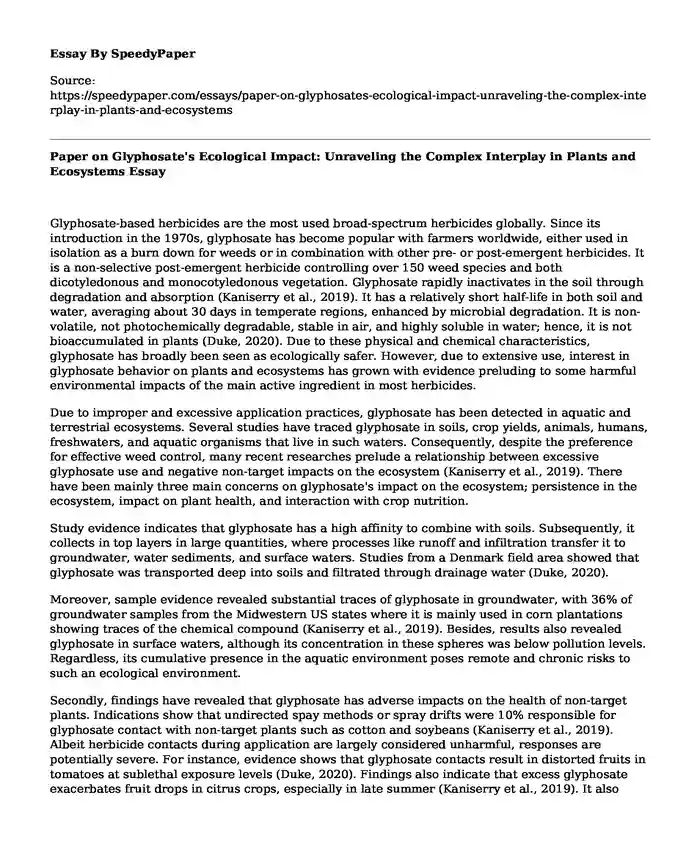
| Type of paper: | Essay |
| Categories: | Environment Ecology |
| Pages: | 3 |
| Wordcount: | 633 words |
Glyphosate-based herbicides are the most used broad-spectrum herbicides globally. Since its introduction in the 1970s, glyphosate has become popular with farmers worldwide, either used in isolation as a burn down for weeds or in combination with other pre- or post-emergent herbicides. It is a non-selective post-emergent herbicide controlling over 150 weed species and both dicotyledonous and monocotyledonous vegetation. Glyphosate rapidly inactivates in the soil through degradation and absorption (Kaniserry et al., 2019). It has a relatively short half-life in both soil and water, averaging about 30 days in temperate regions, enhanced by microbial degradation. It is non-volatile, not photochemically degradable, stable in air, and highly soluble in water; hence, it is not bioaccumulated in plants (Duke, 2020). Due to these physical and chemical characteristics, glyphosate has broadly been seen as ecologically safer. However, due to extensive use, interest in glyphosate behavior on plants and ecosystems has grown with evidence preluding to some harmful environmental impacts of the main active ingredient in most herbicides.
Due to improper and excessive application practices, glyphosate has been detected in aquatic and terrestrial ecosystems. Several studies have traced glyphosate in soils, crop yields, animals, humans, freshwaters, and aquatic organisms that live in such waters. Consequently, despite the preference for effective weed control, many recent researches prelude a relationship between excessive glyphosate use and negative non-target impacts on the ecosystem (Kaniserry et al., 2019). There have been mainly three main concerns on glyphosate's impact on the ecosystem; persistence in the ecosystem, impact on plant health, and interaction with crop nutrition.
Study evidence indicates that glyphosate has a high affinity to combine with soils. Subsequently, it collects in top layers in large quantities, where processes like runoff and infiltration transfer it to groundwater, water sediments, and surface waters. Studies from a Denmark field area showed that glyphosate was transported deep into soils and filtrated through drainage water (Duke, 2020).
Moreover, sample evidence revealed substantial traces of glyphosate in groundwater, with 36% of groundwater samples from the Midwestern US states where it is mainly used in corn plantations showing traces of the chemical compound (Kaniserry et al., 2019). Besides, results also revealed glyphosate in surface waters, although its concentration in these spheres was below pollution levels. Regardless, its cumulative presence in the aquatic environment poses remote and chronic risks to such an ecological environment.
Secondly, findings have revealed that glyphosate has adverse impacts on the health of non-target plants. Indications show that undirected spay methods or spray drifts were 10% responsible for glyphosate contact with non-target plants such as cotton and soybeans (Kaniserry et al., 2019). Albeit herbicide contacts during application are largely considered unharmful, responses are potentially severe. For instance, evidence shows that glyphosate contacts result in distorted fruits in tomatoes at sublethal exposure levels (Duke, 2020). Findings also indicate that excess glyphosate exacerbates fruit drops in citrus crops, especially in late summer (Kaniserry et al., 2019). It also increases fruit falls in early-season grapefruits and oranges.
Thirdly, findings reveal that glyphosate is a divalent metal cation chelator and is perceived as responsible for reduced nutrient uptake and translocation in plants. Latest studies on the chelating influences of glyphosate revealed that it is a significant contributor to nutrient deficiency in crops. Study results found that glyphosate residues can decrease micronutrients such as iron and manganese uptake in non-target plants and yield glyphosate-metal complex combinations in vegetative tissues rhizosphere (Kaniserry et al., 2019). Therefore, glyphosate undermines crop nutrients and subsequently those who feed on such crops.
References
Duke, S. O. (2020). Glyphosate: environmental fate and impact. Weed Science, 68(3), 201-207. https://www.cambridge.org/core/journals/weed-science/article/abs/glyphosate-environmental-fate-and-impact/85C5628F98E45060AE0B7046F11361E2
Kanissery, R., Gairhe, B., Kadyampakeni, D., Batuman, O., & Alferez, F. (2019). Glyphosate: Its environmental persistence and impact on crop health and nutrition. Plants, 8(11), 499. https://www.researchgate.net/publication/337223604_Glyphosate_Its_Environmental_Persistence_and_Impact_on_Crop_Health_and_Nutrition
Cite this page
Paper on Glyphosate's Ecological Impact: Unraveling the Complex Interplay in Plants and Ecosystems. (2024, Jan 22). Retrieved from https://speedypaper.net/essays/paper-on-glyphosates-ecological-impact-unraveling-the-complex-interplay-in-plants-and-ecosystems
Request Removal
If you are the original author of this essay and no longer wish to have it published on the SpeedyPaper website, please click below to request its removal:
- Essay Sample to Check: Current Environmental Issues and Possible Solutions
- Eccay Example on Naval Architecture
- Free Essay on the Ted Talk Video on Cesar Harada
- Free Essay: Can Renewables Satisfy the World's Demand for Power?
- Free Essay: Ethics and Sustainability of Nuclear Energy
- Paper Sample on Unlocking the Environmental, Economic, and Social Benefits of Recycling
- Free Essay: Hydraulic Fracking Effect on Global Warming
Popular categories




